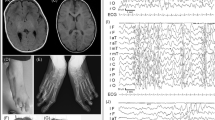Abstract
DiGeorge (DGS, MIM 188400) and velocardiofacial (VCFS, MIM 192430) syndromes may present many clinical problems including cardiac defects, hypoparathyroidism, T-cell immunodeficiency and facial dysmorphism1. They are frequently associated with deletions within 22q11.2, but a number of cases have no detectable molecular defect of this region2,3. A number of single case reports with deletions of 10p suggest genetic heterogeneity of DGS. Here we compare the regions of hemi-zygosity in four patients with terminal deletions of 10p (one patient diagnosed as having hypoparathyroidism and three as DGS) and one patient with a large interstitial deletion (diagnosed as VCFS). Fluorescence in situ hybridization (FISH) analysis demonstrates that these patients have overlapping deletions at the 10p13/10p14 boundary. A YAC contig spanning the shortest region of deletion overlap (SRO) has been assembled, and allows the size of SRO to be approximated to 2 Mb. As with deletions of 22q11, phenotypes vary considerably between affected patients. These results strongly support the hypothesis that haploinsufficiency of a gene or genes within 10p (the DGSII locus) can cause the DGS/VCFS spectrum of malformation.
This is a preview of subscription content, access via your institution
Access options
Subscribe to this journal
Receive 12 print issues and online access
$209.00 per year
only $17.42 per issue
Buy this article
- Purchase on Springer Link
- Instant access to full article PDF
Prices may be subject to local taxes which are calculated during checkout
Similar content being viewed by others
References
Wilson, D.I., Burn, J., Scambler, P. & Goodship, J. Syndrome of the month: DiGeorge Syndrome Part of CATCH-22. J. Med. Genet. 30, 852–856 (1993).
Wadey, R. et al. Isolation of a gene encoding an integral membrane protein from the vicinity of a balanced translocation breakpoint associated with the DiGeorge syndrome. Hum. Mol. Genet. 4, 1027–1034 (1995).
Morrow, B. et al. Molecular definition of the 22q11 deletions in velo-cardio-facial syndrome. Am. J. Hum. Genet. 56, 1379–1390 (1995).
Hudson, T.J. et al. An STS-based map of the human genome. Science 270, 1945–1954 (1996).
Halford, S. et al. Isolation of a putative transcriptional regulator from the region of 22q11 deleted in DiGeorge Syndrome, Shprintzen syndrome and familial congenital heart disease. Hum. Mol. Genet. 2, 2099–2107 (1993).
Lindsay, E.A., Halford, S., Wadey, R., Scambler, P.J. & Baldini, A. Molecular cytogenetic characterisation of the DiGeorge syndrome region using fluorescence in situ hybridisation. Genomics 17, 403–407 (1993).
Lindsay, E.A., Greenberg, F., Shaffer, L.G., Shapira, S.K., Scambler, P.J. & Baldini, A. Submicroscopic deletions at 22q11. 2: variability of the clinical picture and delineation of a commonly deleted region. Am. J. Med. Genet. 56, 191–197 (1995).
Goodfellow, P.J., Nevenlinna, H.A., Gorman, P., Sheer, D., Lam, G. & Goodfellow, P.N. Assignment of the gene encoding the beta subunit of the human fibronectin receptor to chromosome 10p11.2. Ann. Hum. Genet. 53, 15–22 (1989).
Koseki, H. et al. Fine genetic mapping of the proximal part of mouse chromosome 2 excludes Pax-8 as a candidate gene for Danforth's short tail. Mammalian Genome 4, 324–327 (1993).
Larin, Z., Monaco, A.P. & Lehrach, H. Yeast artificial chromosome libraries containing large inserts from mouse and human DNA. Proc. Natl. Acad. Sci. USA 88, 4123–4127 (1991).
Lai, M.M.R., Scriven, P.N., Ball, C. & Berry, A.C. Simultaneous partial monosomy 10p and trisomy 5q in a case of hypoparathyroidism. J. Med. Genet. 29, 586–588 (1992).
Lynch, S., Brown, J., Cross, I., Milligan, D. & Goodship, J. Comparison of facial features of DiGeorge syndrome (DGS) due to deletion 10p13–10pter with DGS due to 22q11 deletion. J. Med. Genet 32, 149 (1995).
Lipson, A. et al. Velo-cardio-facial and partial DiGeorge syndrome in a child with interstitial deletion at 10p13 — implications for cytogenetics and molecular biology. Am. J. Med. Genet. (in the press).
Greenberg, F., Valdes, C., Rosenblatt, H.M., Kirkland, J.L. & Ledbetter, D.H. Hypoparathyroidism and T cell immune defect in a patient with 10p deletion syndrome. J. Pediatr. 109, 489–492 (1986).
Schuffenhauer, S. et al. DiGeorge syndrome and partial monosomy 10p: case report and review. Annal Genetique 38, 162–167 (1995).
Tagle, T.A. & Collins, F.S. An optimized Alu-PCR primer pair for human-specific amplification of YACs and somatic cell hybrids. Hum. Mol. Genet 1, 121–122 (1992).
Riley, J. et al. A novel, rapid method for the isolation of terminal sequences from yeast artificial chromosome (YAC) clones. Nucl. Acids Res. 18, 2887–2890 (1990).
Lichter, P. et al. High resolution mapping of human chromosome 11 by in situ hybridisation with cosmid clones. Science 247, 64–68 (1990).
Author information
Authors and Affiliations
Rights and permissions
About this article
Cite this article
Daw, S., Taylor, C., Kraman, M. et al. A common region of 10p deleted in DiGeorge and velocardiofacial syndromes. Nat Genet 13, 458–460 (1996). https://doi.org/10.1038/ng0896-458
Received:
Accepted:
Issue Date:
DOI: https://doi.org/10.1038/ng0896-458
This article is cited by
-
Parental Engagement in Identifying Information Needs After Newborn Screening for Families of Infants with Suspected Athymia
Journal of Clinical Immunology (2024)
-
Clinical Practice Guidelines for the Immunological Management of Chromosome 22q11.2 Deletion Syndrome and Other Defects in Thymic Development
Journal of Clinical Immunology (2023)
-
BACs-on-Beads Assay for the Prenatal Diagnosis of Microdeletion and Microduplication Syndromes
Molecular Diagnosis & Therapy (2021)
-
Inborn errors of thymic stromal cell development and function
Seminars in Immunopathology (2021)
-
A recurrent missense variant in EYA3 gene is associated with oculo-auriculo-vertebral spectrum
Human Genetics (2021)



